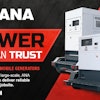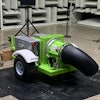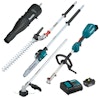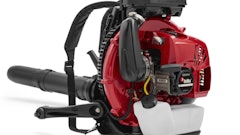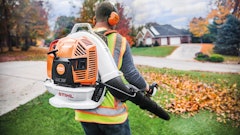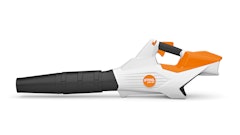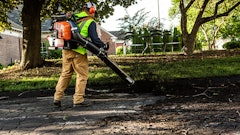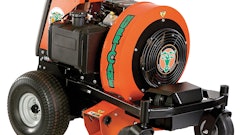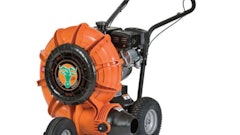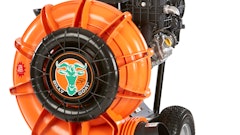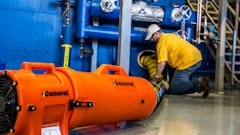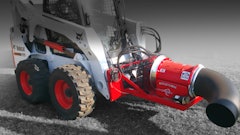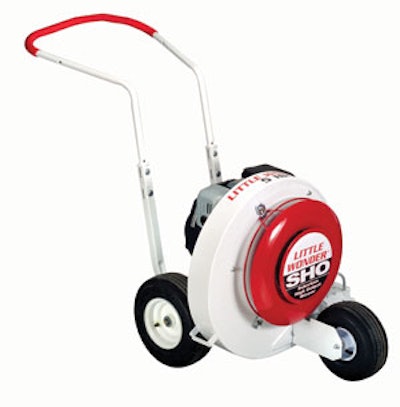
After 25 years in business, Bob Paradise, general manager of Midwest Asphalt Coatings in Lee Summit, MO, knows what it takes to get the job done.
"Cleanliness means nearly everything on a sealcoating job," Paradise says. "We use a wheel blower on every project, the goal being to get rid of all debris before we do any sealcoating."
Midwest Asphalt Coatings equips its crews with 16-hp Billy Goat blowers. "We always use the biggest blower we can, nothing less," Paradise emphasizes. "Again, the goal is to get the surface as clean as possible before applying sealcoat." He says his crews "beat the living daylights" out of the machines, taking them on and off trailers and running them virtually all day long. Despite the rough treatment, he expects the units to deliver optimum performance throughout the season and last two full seasons before replacing them.
Carving out a niche in the commercial sealcoating market, Midwest Asphalt Coatings has different expectations out of its equipment than, for instance, a contractor sealing residential driveways or striping small parking lots. The key is to match the blower to the application.
Billy Goat offers small and medium-frame wheel blower models that range anywhere in list price from $699 to $1,479. The smallest blower is powered by a 5-hp Honda engine and weighs less than 100 pounds.
The three mid-size units all share the same chassis and differ primarily in horsepower offerings, available in 8-, 9-, 10-, and 13-hp models. The manufacturer's largest blower is available with a Briggs & Stratton Vanguard 16-hp engine.
"In general, blowers with bigger engines are able to deliver more air and velocity than their smaller counterparts," says Billy Goat president Will Coates. "Our 16-hp unit, for example, has twice the output of our 9-hp offering. They are both effective. It just depends on the size of the job and the amount of debris to be removed."
Engine horsepower and air velocity are important criteria for wheel blowers, but they are not the only features that count, says Coates.
"Weight is also an important consideration for the paving contractor. Any kind of incline, change in direction or momentum, in addition to pushing a machine back and forth all day long can be tiring. Pavement is hot, too, which adds to operator fatigue," he says. "Weight alone is one reason why a contractor would not want to have the biggest blower money can buy for every application."
Coates says that if he were just starting out he would consider the company's 9-hp Quiet Blower. "It is one of the quietest blowers on the market, it is light weight, and it will meet the needs of small and medium size jobs," he says.
Among features, Billy Goat Quiet Blowers are equipped with nylon fans, which are lighter than metal fans and reduce noise output. As Coates points out, nylon fans also minimize gyroscopic forces. "If you have ever operated a wheel blower, you would understand immediately how a high-speed fan can work against you, especially when making a turn," he says. "Working against this force all day long can be tiring."
Billy Goat blowers feature a welded chassis for added durability and a hand-controlled deflector that can direct the exhaust up and down. "This feature is especially nice when working up close," adds Coates. "Instead of having to tilt the machine, all the operator has to do is squeeze the handle to change the exhaust direction."
Little Wonder wheel blowers come with a similar benefit if not feature. The discharge chute is split, allowing air to travel in two paths. The feature is available on each of six models, equipped with engines that range from 5 to 13 horsepower.
"Time is money for pavement contractors," says Little Wonder Director of Sales Dave Navroth. "The split chute allows operators to essentially accomplish two tasks in one, dislodging up-close stones and pebbles and clearing away the debris from the pavement." An optional swivel wheel kit is another time saver, he adds, noting that it allows operators to turn their blowers 360 degrees with little or no effort, and reduces front tire wear. Height-adjustable handles with an anti-vibration grip help lessen operator fatigue and encourage optimum performance on the job-site.
Little Wonder blowers are also designed to take commercial-type punishment. They come with a five-year warranty made possible in part by features like a continuously welded, heavy-gauge steel blower housing.
Giant-Vac offers 10 wheel blower models, three of which are very popular among pavement contractors — an 8- and 13-hp Kohler-powered model and a 10-hp Briggs & Stratton unit. Each is equipped with "no flat" tires and like Little Wonder has 360 degree swivel kit standard on the Kohler models and optional on the Briggs unit.
Giant-Vac's blowers also feature handles adjustable to four positions, something Sales Manager Al Pacunas says is becoming more important as the demographics of the workforce — such as more women entering the construction industry — change.
"Maneuverability, weight, and the ability of machines to adapt to different-sized people all become increasingly important features," Pacunas says.
Wheel versus backpack
Boston-based TK Asphalt uses a variety of wheel blowers, including Little Wonder, Billy Goat, and Giant-Vac models. In the pavement maintenance business 17 years, the company employs more than 100 people during the busy season on three sealcoating crews, five paving crews, and two striping crews.
"We probably have 14 or 15 wheel blowers in all, from 8-hp models all the way to the big 16-hp machines," says Tony Heffernan, company president. "Crews also carry backpack blowers, which are easier to store and handle than wheel blowers, but they don't clean as well. When it comes to sealcoating especially, you have to get the pavement clean."
Heffernan's company recently made a move away from the bigger horsepower blowers to smaller 11- and 13-hp models. The reason? They are lighter and easier to load and unload, and they perform nearly as well, he notes, giving an example where weight truly makes a difference.
"We have one three-person crew. If we equip that crew with a 16-hp blower, we cannot send the lone person out to the next job ahead of time to clean the drive while the rest of the crew is finishing up," Heffernan says. "It takes two people to unload the large blower. With a smaller blower that one person can handle, an individual can have the drive cleaned by the time the rest of the crew shows up."
It may seem like a small detail, but little things like that add up, says Heffernan, especially with so many crews in the field. TK's blowers run high and hard all day long. Maintenance on them is minimal, the owner notes. Just routine service on the engine, and the blowers are relatively maintenance free. In fact, Heffernan says that having a blower last six or seven years in not unusual. "When an engine wears out, we will simply install a short block for around $200."
Purchasing a wheel blower may seem like a "weighty" issue, and it can be, depending on the application. As Heffernan points out, nothing cleans better than a large 16-hp unit. Yet, the smaller 13-hp blowers come close in terms of performance and they are easier to handle and maneuver.
Features such as adjustable handle-bars, specially designed exhaust chutes, swivel wheels, welded chassis, and lightweight fans help distinguish one brand from another, but all commercial-quality wheel blowers share a common trait. They are designed to be a durable part of your cleanup team for a long time.
Based in Neenah, WI, Rod Dickens is a freelance writer specializing in the construction industry.
